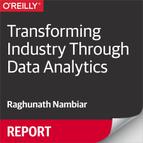Book Description
The information technology revolutions over the past six decades have been astonishing, from mainframes to personal computers to smart and connected economies. But those changes pale in comparison to what’s about to happen. By 2020, seven billion people and roughly 50 billion devices will be connected to the internet, leaving the world awash in data. How do we make sense of it all?
In this insightful book, Raghunath Nambiar from Cisco examines the role of analytics in enabling digital transformation within the enterprise, including challenges associated with the explosion of data. It embraces the need for analytics at the edge of the network with a local context and analytics at the data center core with a global context. He also explores the differences between the four types of analytics—descriptive, diagnostic, predictive, and prescriptive—including the driving factors behind the need for each of them, as well as the analytical systems required to process them to produce actionable insight.
Raghu then takes a deep dive into how the explosion in internet connections affects key industries, and how applied analytics will impact our future. Learn how analytics can make a difference in:
- Smart cities to manage energy, the environment, traffic, parking, structures, waste, safety, and crowds
- Smart energy to enable sustainable and efficient offerings that provide substantial benefits for both providers and customers
- Healthcare to address the aging population, growing shortage of physicians, and rising costs through connected health
- Manufacturing for producing higher quality products, creating new lines of business, reducing time-to-market, and increasing revenue growth
- Transportation to address the increasing demand through collaborative consumption, connected cars, and the potential for autonomous vehicles
